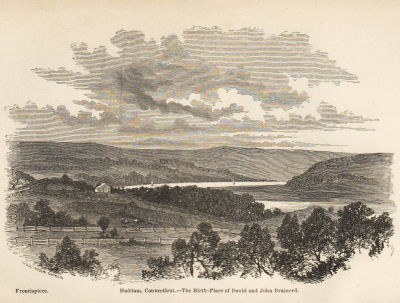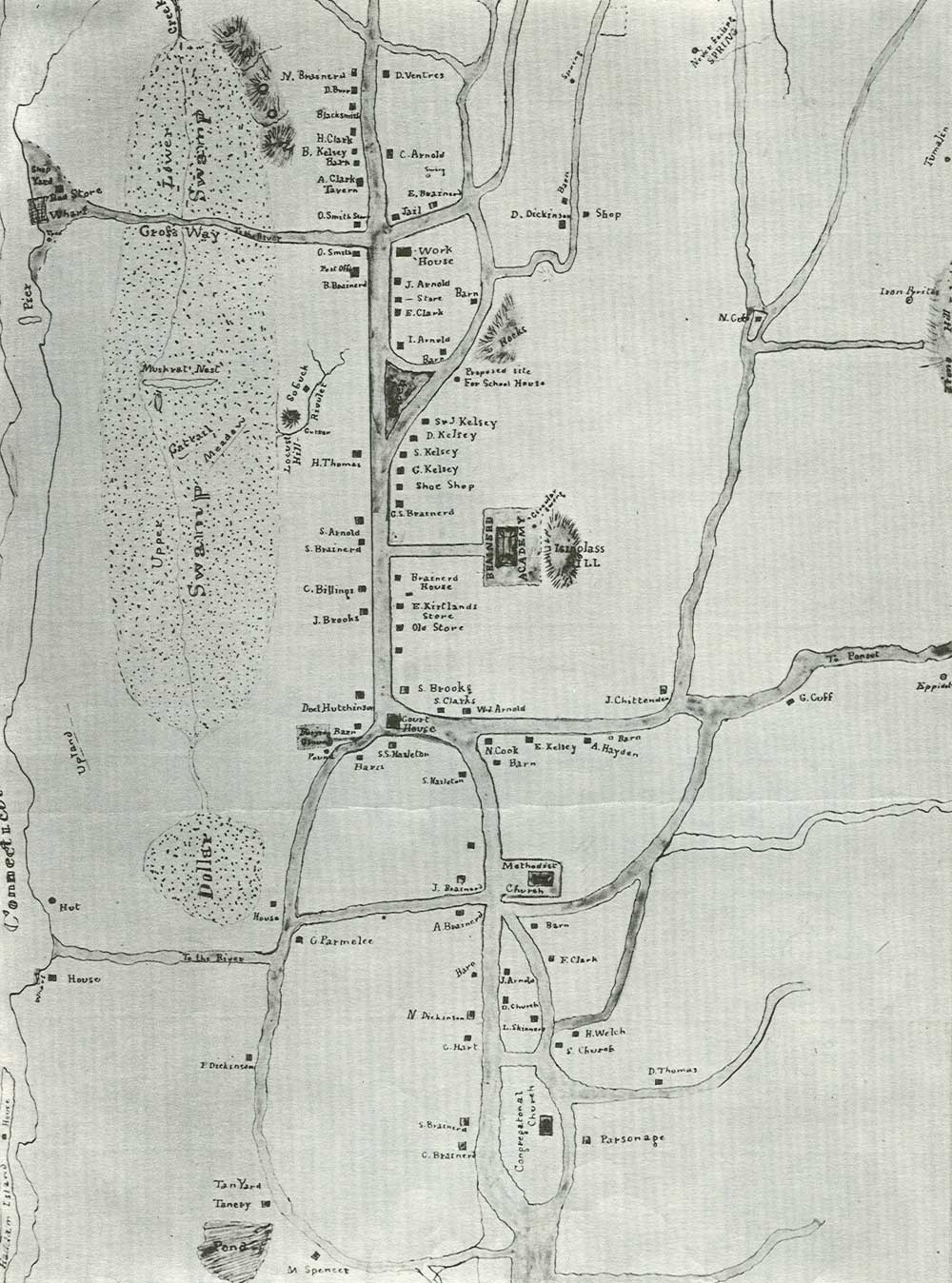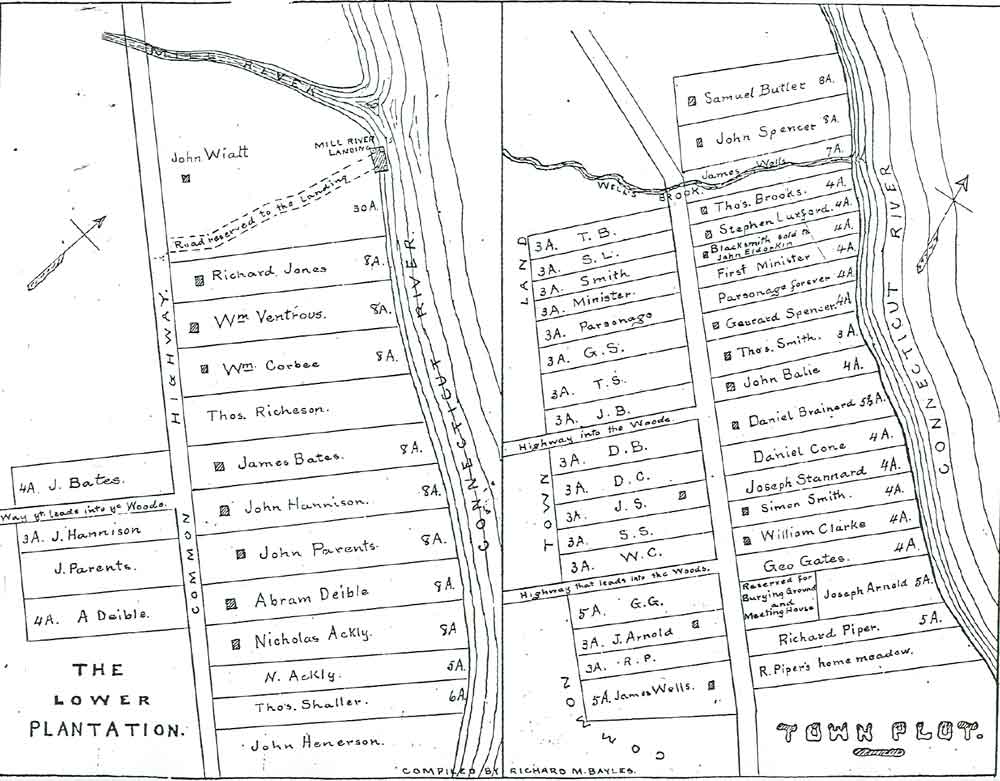A Brief History of Haddam
The Town of Haddam is located in Middlesex County, in the south-central part of Connecticut in the lower Connecticut River Valley. Middletown and East Hampton border the town to the north, East Haddam to the east, Chester and Killingworth to the south, and Killingworth and Durham to the west. With approximately 8,452 residents (2020 census) the town covers 46.7 square miles. Haddam has the distinction of being the only town in the state of Connecticut that is bisected by the Connecticut River, with residents on both sides; Haddam and Higganum are on the west side and Haddam Neck is on the east side.
Plantation at Thirty Mile Island
In 1660 the Connecticut Colonial Legislature sent Matthew Allyn and Samuel Willys down the Connecticut River from Hartford to purchase land from the Wangunk Indian Tribe at the place the English called 'Land of Thirty Mile Island'. There are two schools of thought on how "Thirty Mile(s) Island got its name. Early historians write that the earliest settlers thought the island was thirty miles from the mouth of the "Grate River" at Long Island Sound (it is only 17 miles from the mouth of river). It is also plausible that the Island got its name because it is 30 miles down river from Hartford and the town was settled by men from the Hartford area.
In May 1662 the Englishmen finally purchased land comprising approximately 104 square miles and extending in six miles on each side of the river from the straits at “Pattyquonck” (now Chester) to the Mattabeseck-Mill River (now Middletown) across to the line of Chatham (now East Hampton). The English paid 30 coats (worth approximately $100) for the land from four Native American chiefs, two queens and others. The Native Americans did set aside some property for their own use including 40 acres at Cove Meadow (Chester) and Haddam Island as well reserving the right to hunt and fish where they pleased.
The first settlers were twenty-eight men and their families from Hartford, Wethersfield and Windsor:
- Nicholas & Hannah (Unknown Maiden Name) Ackley
- John & Martha (Steele) Hannison
- Joseph & Elizabeth (Wakeman) Arnold
- Richard & Elizabeth (Carpenter) Jones
- James & Hannah (Withington) Bates
- Stephen Luxford (No Wife Listed)
- John & Lydia (Backus) Bailey
- John Parents (No Wife Listed)
- Daniel & Hannah (Spencer) Brainerd
- Thomas & Alice (Spencer) Shayler
- Thomas & Alice (Spencer) Brooks
- Simon & Elizabeth (Bateman) Smith
- Samuel & Elizabeth (Olmsted) Butler
- Thomas Smith (No Wife Listed)
- William & Katherine (Bunce) Clark
- Gerrard & Hannah (Hills) Spencer
- Daniel & Mehitable (Spencer) Cone
- John & Rebecca (Howard) Spencer
- William Corby (No Wife Listed)
- Joseph & Elizabeth (Spencer) Stannard
- Abraham & Lydia (Tefft) Dibble
- William & Elizabeth (No Maiden Name Listed) Ventres
- Samuel & Anna (Burnham) Gaines
- John & Hannah (Unknown Maiden Name) Webb
- George & Sarah (Olmstead Gates
- James & Elizabeth (Clark) Wells
- Richard Piper
- John & Mary (Bronson) Wyatt
Originally there were two small settlements on the west bank of the river: the Town Plot was laid out along the southern end of what is presently Walkley Hill Road and extended to the old burying ground (Burial Yard at Thirty Mile Island Plantation) and the Lower Plantation was settled south of the Mill Creek in the area now known as Shailerville. Each proprietor was given a home lot and land for farming. There was also land set aside for a meetinghouse and ministers lot. In October 1668 town was incorporated and given the name Haddam after Much Hadham in England. Haddam had very little tillable agricultural land and the best farming land was located along the river. Early residents utilized all of the natural resources available to them including water, fish, timber and granite in order to survive. The Connecticut River was a major source of income and transportation for the first 200 years of the town existence. Shipyards were built along the river, while many other small tributaries provided waterpower for mills and eventually factories.
In 1685 a group of residents moved across the river to settle East Haddam including some members the Gates, Ackley, Brainerd, Cone, Spencer, and Bates families. In 1700 East Haddam formed their own ecclesiastical society and became a separate town in 1734. Haddam Neck, which is also located on the east side of the river, was settled around 1712 but remained a part of Haddam and continues so today.
By 1720 the population of Haddam had grown to 500 and continued to grow steadily, forcing new settlers and younger generations to expand inland to the less fertile areas. Families that came to Haddam in the late 17th century included Walkley, Scovil, Dickinson, Hubbard, Hazelton, Higgins, Knowles, Lewis, Ray, Thomas, Tyler, Burr and Smith, some of which settled in the interior portions of town including Ponsett, Candlewood Hill, Little City, Burr and Turkey Hill.
The Revolutionary War

During the Revolutionary War Haddam men served in the local militia and many citizens participated in privateering, the state sanctioned practice of capturing enemy ships. Privateering gave United States ships permission to capture British ships to cut off their supply lines and furnish our Navy with needed vessels and supplies. Once a ship was captured, it was brought to the nearest friendly port where the ship owner, captain and crew all benefited financially from the seized cargo. It is recorded that in 1779 two British ships, the York and Tryon were captured on the Connecticut River by Haddam-made ships captained by Simon Tyler and Samuel Shaylor.
Haddam, like many other Connecticut towns, served as a provisionary town during the war supplying troops with food including fish, beef and pork. During the winter of 1778 the horses of Washington's dragoons (cavalry) were housed in Haddam and Durham, which seriously depleted the residents' stock of hay and feed. The following year residents protested and the dragoons were moved to Colchester.
After the Revolution many of the town's local farmers were left with farms that were so small in acreage that they were no longer profitable. Because it was common practice for the family farm to be split off to form homesteads for sons, there was a marked decrease in the size of farms in town. As a result of this land shortage, many of the descendants of local farming families emigrated west to places such as New York and Ohio. Despite the land shortage, there was a brief building boom in Haddam after the Revolution. Trade and industry grew and those families involved in local industry built large and ornate homes. Middlesex Turnpike opened in 1802 and as the main road from Saybrook to Hartford it ran directly through the center of Haddam Village. This allowed for easier communication and commercial growth for the town.
Churches
For the first hundred years the Congregational Church was the only organized church in town and the first meetinghouse was erected in 1673-74. Haddam Neck residents joined with Middle Haddam residents to form their own ecclesiastical society in 1740 and the Higganum Congregational Church was formed in 1844. In 1791 the Methodists began to meet in the western part of town and a Methodist Church stood in the Burr District for a number of years. In 1792 a Baptist Congregation was formed and it erected a church in the Shailerville section of town. The Rev. William C. Knowles started the Episcopal Church in the Ponsett section of town in 1861 and the present St. James's Episcopal Church was erected in 1871-73. In 1756 a small group of Catholics settled here but unable to find a priest they returned to Nova Scotia. In 1876 the first mass of local Catholics was held in a private home and a year later Mission Church of St. Peter was erected in Higganum.
Schools
The first record of schools was in 1750 when Nathaniel Spencer, John Ventres and Thomas Brooks were tapped to sit on the school board. Residents paid the schoolmaster for teaching all the male children between 5 and 12 and females between 5 and 7 whether they attended school or not. Early lessons were held in private homes and by 1728 a school was erected near the old burying ground. In 1732 the town voted that lessons would be taught at the schoolhouse for 3 to 5 months of the year and for the remaining part of the year the teacher would travel to outlying districts. Men taught classes in the winter and women taught in the summer months.
By 1814 thirteen school districts had been established in town. Each district erected a small (many one-room) schoolhouse to serve area students. District schoolhouses remained in use until the early 20th century. In the mid-19th century Higganum village's population warranted that a new larger schoolhouse be built. This two-story schoolhouse, which still stands on the south side of Candlewood Hill Road, was known as the "Green School". This building once stood on the Higganum Green and was replaced in 1894 by the Higganum Union School, which was used until 1948.
In 1948 Haddam Elementary was erected on the east side of Saybrook Road and currently houses grades 1 through 6. The Haddam Junior High School (now HK Middle School) was completed in 1960 and in 1970 the town erected a second elementary school off Killingworth Road in the Burr District. Haddam and Killingworth became Regional School District #17 in 1970s and the high school was built on the same campus as the junior high and completed by 1978.
The Civil War
During the Civil War Haddam sent 90 men of service age to join Connecticut Regiments and 23 perished. Most local men served with Company D of the 20th Connecticut Volunteer Infantry and Company A of the 24th Connecticut Volunteer Infantry. General Alexander Shailer, a Union general who lead his regiment in all the battles of the Army of the Potomac was a native of Haddam.
Haddam Center
In 1785 Middlesex County was created from towns from Hartford and New London counties and Haddam and Middletown were selected to share the county seat, an arrangement that lasted over 100 years. As a half-shire town Haddam Village grew as the commercial and institutional center of town. Haddam became a regional center with a county courthouse located in the heart of town and a jailhouse not too far away. The granite jailhouse is one of the town's most impressive structures and continued to be used as a jail until the mid 20th century. Court trials during this era were a form of public entertainment and the presence of a courthouse and jail brought judges, lawyers and visitors to Haddam's center, a great boost for the economy. Roger Sherman and John Trumbull were among the notable lawyers who worked at the Haddam Court.
During much of the 19th century, Haddam village was a bustling community and institutional center of town. Shipbuilding was done on a small scale and the granite quarries became a prominent business in the 1800s, supplying curb and building stone to New Orleans, New York, and Philadelphia. The county court left Haddam in the 1880s and the industrialization of Higganum to the north drew much of the commercial business from the village. Steamboat traffic replaced carriages as the primary means of traveling north and south and the Middlesex Turnpike declined as a major thoroughfare. Following the steamboat was the Connecticut Valley Railroad in 1871, which provided an easy and quick route from Old Saybrook to Hartford that bypassed local businesses.
With the invention of the automobile, the old Middlesex Turnpike saw an increase in traffic again and small roadside eateries and shops opened to cater to travelers. The village of Haddam remained the institutional center of town with the town hall, library, county orphanage and jail onto the 20th century.
| Year | Population |
|---|---|
| 1800 | 2,307 |
| 1850 | 2,279 |
| 1900 | 2,015 |
| 1950 | 2,636 |
| 2000 | 7,157 |
| 2010 | 8,346 |
Sources for Haddam History:
Bayles, Richard M. "Town of Haddam." In History of Middlesex County, Connecticut, edited by J. B. Beers. New York: J. B. Beers and Company, 1884.
Beers, J. H. Commemorative Biographical Record of Middlesex County, Chicago: J.H. Beers, 1903
Brainerd, Eveline Warner. "Haddam Since the Revolution." Connecticut Magazine, December 1899, pp.591-604
____________________. "The Plantation of Thirty Mile Island." Connecticut Magazine, November 1899, pp. 543-552
Brooks, Lillian Kruger. Life Flows Along Like a River: A History of Haddam Neck. Haddam Genealogical Group, 1972.
Cunningham, Janice and Elizabeth A. Warner. Portrait of a Town: The History and Architecture of Haddam, Connecticut. Greater Middletown Preservation, Middletown, CT, 1984
Field, David Dudley. A Statistical Account of the County of Middlesex in Connecticut, Middletown, Connecticut: Clark and Lyman, 1819
___________________. A History of the Towns of Haddam and East Haddam, Middletown, Connecticut: Loomis and Richards, 1814
Knowles, The Reverend William C. By Gone Days of Ponset-Haddam. New York: Printed by the author, 1914.
Sandin, Katherine. Country Church, Country People 1740-1974. Detroit: Harlow Press, 1974.
Selden, Henry. "Haddam Neck." In the History of Middlesex County, Connecticut, edited by J.B. Beers. New York: J.B. Beers and Company, 1884.
Two-Hundredth Anniversary of the First Congregational Church of Haddam, Connecticut, 1700-1900. Haddam, Connecticut: The DeVinne Press, 1902


